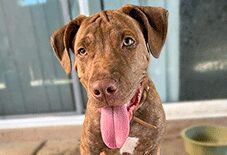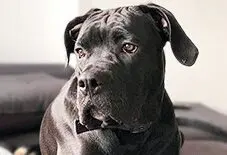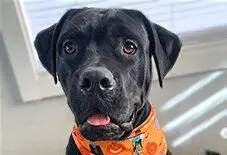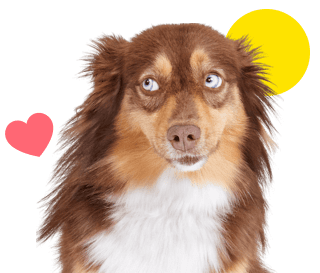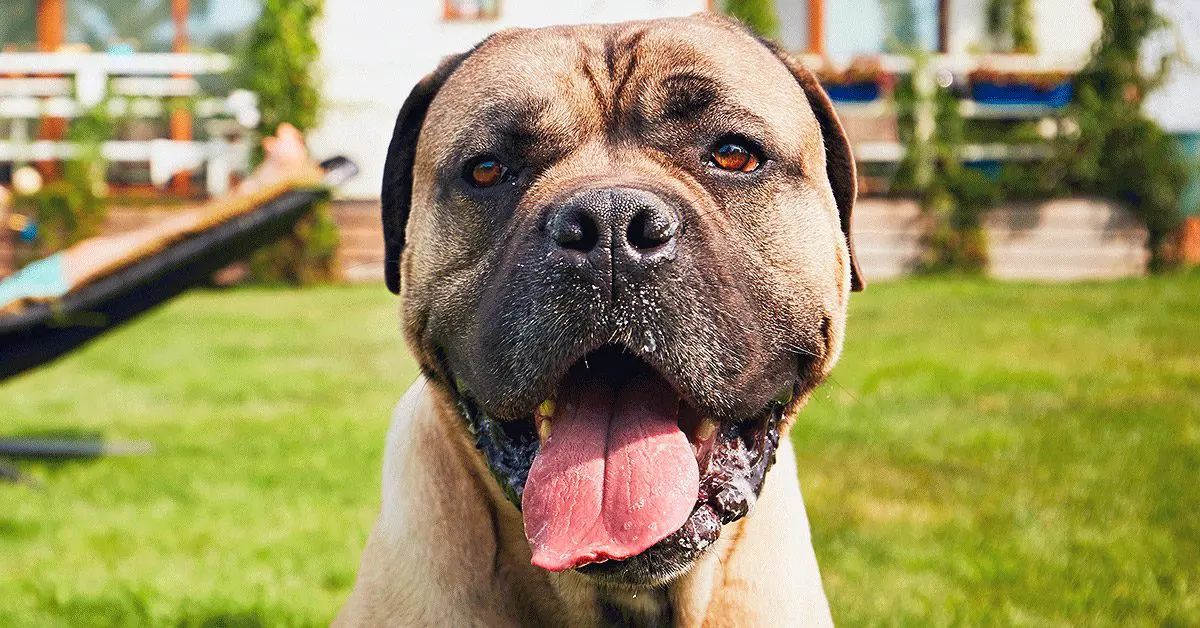
Meet the Cane Corso
High Doggy I.Q.
Protective Pooch
Top Working Dog
If you’re looking for a powerful and confident four-legged companion, I’m the dog for you! I’m famous for my big, muscular build and assertive pawsonality. These traits make me one of the best guard dogs in town and while I may look furocious, it just comes from my instinctual need to protect the ones I love! After all, my name roughly translates to “guardian” in Latin.
I learn new things easily, but still need plenty of training as a pup. Without it, I can become feisty around unfamiliar people and animals. Since I need a firm handler, the best companions for me are experienced dog parents, and the best home is one without other pets. I also have high levels of energy, so my owners will need to take me on lots of long walks! I may be a little intimidating before you get to know me, but I’m also extremely loyal. If you put in the bonding and training time, I’ll make you fall head over paws with my self-assured personality and commitment to mastering anything I set my mind to!
Ready to learn more about me? Let’s dig in.
Ready to learn more about me? Let’s dig in.
 My Many Looks
My Many Looks

Black
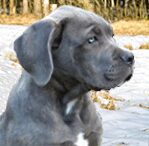
Gray
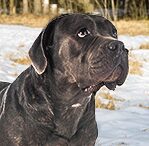
Black Brindle

Red
 My Breed Characteristics
My Breed Characteristics
 Furbulous Fact
Furbulous Fact
Pretty much everyone views us as tough and vicious, but that’s not completely our fault. After all, we were originally bred to protect people and land from everything – even lions! Seriously, legend has it that nearly 1,000 years ago, we used to fight lions in the Tibetan Highlands in order to protect ancient monasteries. I don’t think any of us would fight a lion today, but sometimes our growls sound a lot like theirs!
 As I Grow Up
As I Grow Up
As you can see, we Cane Corsi age pretty gracefully. Here are a few key milestones in my growth and development to be aware of as I grow up from a pupper to an adult and senior!
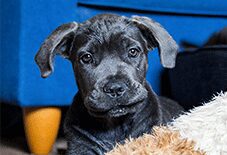
Puppy2 Mos-1.5 Yrs
I have lots of energy, but my bones and muscles won’t fully develop until 18 months, so be gentle with me during playtime.
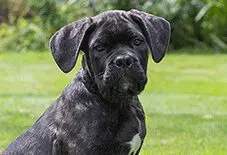
Adult2-4 Years
Big dogs like me don’t emotionally mature until the two-year mark. Train me right as a puppy, so I won’t try to dominate the house.
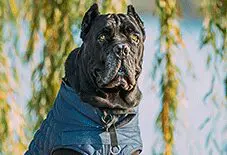
Senior8-12 years
I’m prone to hip dysplasia, eye issues, and bloat. Learn about the symptoms of these issues so you can take me to the vet right away.
 History of My Breed
History of My Breed
Our history can be traced back to Ancient Greece – opa! We belong to a subcategory of working breeds called molossian dogs, which comes from the name of an ancient Greek tribe, Molossi. They were famous for breeding Mastiff-type dogs like us! Our name translates to “guardian dog,” so you know we were built to protect.
When the Roman Empire was at its most powerful, armies that took over Greek islands brought us back to Italy to breed us with native Italian breeds. That’s how our closest ancestors were born, and we actually share this ancestor with Neopolitan Mastiffs – no wonder we both have such good looks!
Our fearlessness and ferocity made us the pawfect sidekicks for explorers trying to take over more land. Ancient tales say that our ancestors were even bigger and scarier looking than us! Our owners used to strap buckets of flaming oil onto our backs and send us out to charge enemy lines – backs ablaze!
When the Western Empire dissolved in the fifth century, our Italian breed was out of work. We found ourselves with regular dog day jobs like hunting wild boar, farming, and guarding livestock and farm houses as watchdogs. We looked pretty good prancing around the Italian countryside until WWI and WWII brought invaders into the peninsula. On top of that, industrialization put us out of work because machines could do our jobs quicker than we could. This led to a decline in our population and we were almost completely extinct by the mid-20th century.
Thankfully, some of us were still thriving in the backcountry of Southern Italy. In the 1970s, a group of Italians came together to revive our breed of big dogs! The Society Amorati Cane Corso was formed in 1983 and by the 1990s, we were being exhibited in European dog shows. We first came to the United States in 1988 and were recognized by the AKC in 2010.
 Pawesome Pups to Parent
Pawesome Pups to Parent
In addition to purebred Cane Corsi like me, there are tons of pawfectly cute mixed-breed Cane Corsi that are looking to find their furever homes. You can learn where to find your next pet below!
 Care Tips
from Dr. Marc Elie, Veterinarian
Care Tips
from Dr. Marc Elie, Veterinarian 
Keep an eye on your Cane Corso’s eyes.
Cane Corsi can develop a condition known as “cherry-eye,” which is a prolapse of the gland of the nictitating membrane – one part of the eye that produces tears. If you start to notice irritated, red, or teary eyes in your pup, it’s a good idea to connect with a doggy eye doctor (ophthalmologist) to address the issue before other eye problems develop.
Get key health screenings your vet recommends.
It’s important to get regular screenings to catch things like hip dysplasia and arthritis. You won’t always be able to catch signs and symptoms on your own, so make sure you get your pup checked out by the vet on a regular basis throughout their lifetime.
Create a diet for your pup that promotes healthy development.
Cane Corso puppies need proper nutrition for growth and to avoid developmental orthopedic disease, which impairs the bones, joints, or muscles. There are dog foods designed specifically for large dog breeds, and since Cane Corsi typically grow to be over 100 pounds, proper food is essential to their overall health. Work with your vet to get dietary recommendations for your growing giant breed pup.
 Training Tips
from Trainers & Behavior Specialists
Training Tips
from Trainers & Behavior Specialists

Size up your Cane Corso’s equipment as they grow.
During their first year of development, Cane Corsi will seem to grow before your eyes. Make sure you observe your Corso’s growth rate closely, as they’ll outgrow their equipment (many times) during their rapid growth stage of development – until they stop growing at about 18 months. Check their collar often to make sure it isn’t getting too tight. Replace it with a larger one before it starts to squeeze their skin. Investing in adjustable equipment is another great way of making sure your pup is comfortable in their equipment as it grows. - Laura Monaco Torelli, Certified Dog Trainer
Train your pup early to prevent overly rough play.
If you're playing with a chew toy and the dog's teeth even lightly graze your flesh – playtime is over. If they accidentally nip you – even if it doesn’t hurt – give a high-pitched yelp!, take away the toy, and ignore them for a moment. While it may be difficult to ignore your adorable Cane Corso pup, you’ll be teaching them an important life lesson: Any time your teeth come up against human skin, all the fun stops. - Richard Lovejoy, Professional Remote Dog Trainer
Coach your Cane Corso to be a great leash walker.
Cane Corsos can be a gregarious and friendly breed, but from time to time, people on the street still freeze up around them. Unless you train your dog to be a good canine citizen, they might bark as a communication strategy, which can be scary for passersby. Counter this early on by proactively coaching your Cane Corso to be a respectful leash walker. Take them on plenty of sniff walks, exploring environments, with lots of treats to reward their good behavior. - Laura Monaco Torelli, Certified Dog Trainer

 Why Get Dog Insurance?
from Pumpkin®
Why Get Dog Insurance?
from Pumpkin®
While Cane Corsi are a generally healthy breed, unexpected ruh-rohs can happen to any dog at any age. If your pup gets hurt or sick, pet insurance can help you say ‘yes’ to the best care, even when it’s costly. When it comes to shopping for this breed, you’ll want to choose insurance plans like Pumpkin's, which can help cover the costs associated with the hereditary conditions Cane Corsi are prone to developing. While a reputable breeder will conduct genetic testing on your pup’s parents to help minimize the chances of passing down hereditary conditions – they can’t always be avoided. Let’s look at some common ones, and how Pumpkin Dog Insurance plans could help cover the cost of care!
 Hip Dysplasia
Hip Dysplasia
This orthopedic condition happens when the ball and socket of the hip joint doesn’t develop or work properly, leading to joint deterioration, pain, lameness, and/or arthritis. Mild cases can be managed with prescription meds and physical therapy, but severe ones may require costly surgery.
- Cost to Treat
- $1,500-$7,000 (surgical)
- Pumpkin Pays Back*
- $1,350-$6,300
 Epilepsy
Epilepsy
This neurological disorder causes recurring seizures and can be life-threatening. Based on the type, severity and frequency of seizures, Anti-Epileptic Drugs may be prescribed to manage the condition, but they can be expensive and cause side effects. Cane Corsi mostly show signs around age two.
 Demodectic Mange
Demodectic Mange
This condition happens when microscopic mites take over hair follicles and the immune system can’t suppress them. They irritate the skin, cause infection, inflammation, scarring, and hair loss. Some cases heal on their own, but others will require anti-mite and anti-inflammatory creams.
- Cost to Treat
- $300-$500
- Pumpkin Pays Back*
- $270-$450
 Cherry Eye
Cherry Eye
This eyelid abnormality occurs when the third eyelid gets inflamed and protrudes. Mastiff-type dogs, like Cane Corsi, have almond-shaped eyes which are prone to infection. This condition isn’t life-threatening, just unsightly and uncomfortable, and is treated by removing the affected gland.
- Cost to Treat
- $250-$2,500
- Pumpkin Pays Back*
- $225-$2,250
*Example illustrates reimbursement of a covered vet bill at a 90% reimbursement rate, where the annual deductible had already been satisfied and the annual limit had not yet been met. Coverage and reimbursement results vary based on policy options.

